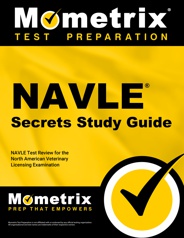The ICVA administers the North American Veterinary Licensing Examination (NAVLE) as a requirement for licensure to practice veterinary medicine in the US and Canada.
Click “Start Test” above to take a free NAVLE practice test!
NAVLE Eligibility
To be eligible for the NAVLE exam, you must meet ONE of the following requirements:
- You must be enrolled in or a graduate of an AVMA-accredited veterinary school
- You must be enrolled in or certified by the Educational Commission for Foreign Veterinary Graduates (ECFVG) or the Assessment of Veterinary Education Equivalence (PAVE)
NAVLE Exam Outline
The NAVLE exam contains 360 multiple-choice questions, 60 of which are unscored, and you will have a time limit of 6.5 hours. The exam is administered in six blocks, with each block containing 60 questions.
The exam is split into four competency domains.
1. Clinical Practice (70%)
The questions in this domain test your knowledge and skills related to gathering and interpreting data and health maintenance and prevention.
Data Gathering and Interpretation
- Record creation, maintenance, and proficiency
- Diagnosing the patient and developing treatment plans accordingly
- Interpreting cytologic specimens, diagnostic images, and laboratory tests
- Interpreting findings from a physical examination
- Interpreting findings from a postmortem specimen
- Interpreting principles of pathophysiology and mechanism of action
- Interpreting results of a system-specific examination
- Investigating possible exposure of companion animals to toxins
- Investigating possible exposure of food or game animal to toxins
- Observing/interpreting an animal’s mental status and other aspects of behavior
- Performing system-specific examination
- Prioritizing the need for diagnostic procedures considering available resources
- Reading and interpreting production records or farm-based computer reports to understand herd-level health parameters
- Reviewing animal medical records to determine health status
Health Maintenance and Problem Management
- Administering a biological or pharmacological agent other than anesthesia
- Administering general anesthesia, both general and local
- Applying a splint, cast, or another stabilization device
- Caring for wounds or surgical incisions
- Determining prognosis
- Establishing a treatment and rehabilitation plan
- Evaluating a treatment outcome
- Formulating/evaluating a behavior modification plan
- Formulating patient/herd/population management and treatment plans
- Performing common therapeutic/surgical procedures
- Performing major surgical procedures
- Prescribing a biological or pharmacological agent
- Referring clients to veterinary specialists for further diagnostic studies or treatment
- Synthesizing multiple sources of diagnostic information, including local disease prevalence, to determine diagnosis
- Treating minor injuries or trauma
2. Communication (8%)
The questions in this domain test your ability to communicate with clients and other professionals in the workplace.
Communication with Clients
- Advising a client on health maintenance for the herd, flock, or individual pet
- Advising a client regarding appropriate and inappropriate pharmacy compounding
- Discussing euthanasia with a client
- Discussing strategies with a producer or client to reduce antibiotic resistance and/or antibiotic residues
- Discussing the limits of legal extra-label drug use with the client
- Ensuring that a client understands the effects of prescribed pharmaceuticals, including chemotherapeutics
- Explaining diagnosis and prognosis to clients using lay terminology
- Explaining research results to a client, describing their implications for animal care
- Helping clients differentiate trustworthy from unreliable information to support the care of their animals
- Informing a client of bad news
- Instructing clients on how to obtain diagnostic information from an animal’s home environment
- Instructing clients on methods for isolating and quarantining diseased animals
- Negotiating a payment plan with a client
- Obtaining informed consent from a client
- Providing instruction regarding food safety practices
- Providing verbal instructions to a client regarding follow-up care
- Recommending management options to clients that are consistent with their cultural norms and personal values
- Referring a client for grief counseling
- Talking with a client to clarify concerns and expectations regarding the type and level of care
- Teaching a client about preventive care
- Using appropriate communication techniques
- Writing a summary of animal care instructions for a client
Communication with Veterinary and Other Professionals
- Building relationships with junior colleagues or new graduates
- Consulting with other veterinarians or veterinary specialists regarding animal care
- Delegating delivery of veterinary care and services to associates or staff
- Delivering verbal case summaries to other veterinarians or members of the healthcare team
- Describing disaster preparedness plan to coworkers
- Engaging regulatory bodies to improve standards of practice or to address other professional issues
- Explaining the results of the research to non-veterinary health workers
- Guiding the work of associates or other staff in the delivery of veterinary services
- Mentoring and supervising veterinary and veterinary technician students
- Responding to unprofessional or unethical behavior in others
- Training staff in animal health and care
- Writing a case summary for use by other veterinarians or healthcare team members
3. Professionalism, Practice Management, and Wellness (7%)
The questions in this domain test your knowledge and skills pertaining to professional development and veterinary practice management.
Professional Development and Life-Long Learning
- Exchanging personal information
- Attending professional development seminars
- Emerging technologies
- Using reference materials
Veterinary Practice Management
- Apply appropriate animal restraint
- Describe the workings of the benefit plan to staff
- Develop a budget for your practice or employer
- Develop standard operating procedures (e.g., procedures manual for practice or work environment)
- Evaluate and purchase major medical equipment
- Evaluate and purchase office/practice management software
- Evaluate new medications, products, or treatment procedures to determine suitability for own practice
- Negotiate work or practice arrangements (e.g., compensation, work schedule) with colleagues
- Prepare or update the employee handbook
- Purchase expendable supplies
- Review practice management data, including business and financial records
- Supervise paraprofessional or technical support staff
4. Preventive Medicine and Animal Welfare (15%)
The questions in this domain test your knowledge and skills pertaining to health and safety and animal welfare issues.
Environmental Health and Safety
- Isolation/quarantining techniques
- Proper waste disposal
- Informing the community about waste management/removal
Veterinary Public Health
- Reporting disease concerns to state, regional, and national agencies
- Investigating and documenting a disease outbreak
- Conducting community education workshops related to disease and animal health
- Collaborating with community groups and government agencies concerning diseases and health risks
Animal Welfare Issues and Concerns
- Certifying that animal products meet acceptable standards
- Animal welfare audits
- Vaccinations
- Deworming
- Explaining concerns to a client
Check out Mometrix's NAVLE Study Guide
Get practice questions, video tutorials, and detailed study lessons
Get Your Study Guide
Registration
To register for the exam, you must fill out an application on the ICVA website and pay the $760 testing fee. The due dates for applications are February 1 and August 1.
Once your application has been approved, you will receive a confirmation email with instructions on how to schedule your exam appointment with Prometric.
NAVLE Online Prep Course
If you want to be fully prepared, Mometrix offers an online NAVLE prep course designed to give you everything you need to succeed!
Here’s what you’ll find in the NAVLE course:
- 70+ Review Lessons Covering Every Topic
- 600 NAVLE Practice Questions
- 950+ Digital Flashcards
- Money-back Guarantee
- Mobile Access
Everyone learns differently, so we’ve tailored the NAVLE online prep course to ensure every learner has what they need to prepare for the NAVLE exam.
Click below to check it out!
Test Day
On the day of the exam, you should arrive 30 minutes before your scheduled appointment time. Once you arrive, you will need to provide your scheduling permit and a valid form of government-issued photo ID.
Once you have been approved for testing, you will be asked to leave all personal items in a secured locker located outside the testing room. This includes your cell phone, watch, bags, and food items.
After your items have been stored, you will be led to your testing area and given a brief tutorial on the testing system before the exam begins.
Scores
Your NAVLE score is based on a scaling system. This system takes your raw score, which is the number of questions you answered correctly, and converts it to a numerical score reported on a range of 200-800. The passing score is a scaled score of 425.
Your score report will be available 3-5 weeks after testing. Your report will contain a bar graph that shows a distribution of scores from a recent group of NAVLE test-takers, as well as your score in relation to the passing score.
Retaking the Test
If you fail the exam, you are allowed to retake it up to five times in your lifetime.
Check out Mometrix's NAVLE Flashcards
Get complex subjects broken down into easily understandable concepts
Get Your Flashcards
FAQs
Q
How many questions are on the NAVLE exam?
A
There are 360 multiple-choice questions on the exam, 60 of which do not count toward your score.
Q
How long is the NAVLE exam?
A
The time limit for the exam is 6.5 hours.
Q
What is the passing score for the NAVLE exam?
A
To pass the exam, you must achieve a scaled score of at least 425.
Q
When are NAVLE scores released?
A
You should receive your score report about four weeks after you take the exam.
Q
How much does the NAVLE exam cost?
A
The examination fee is $760.




